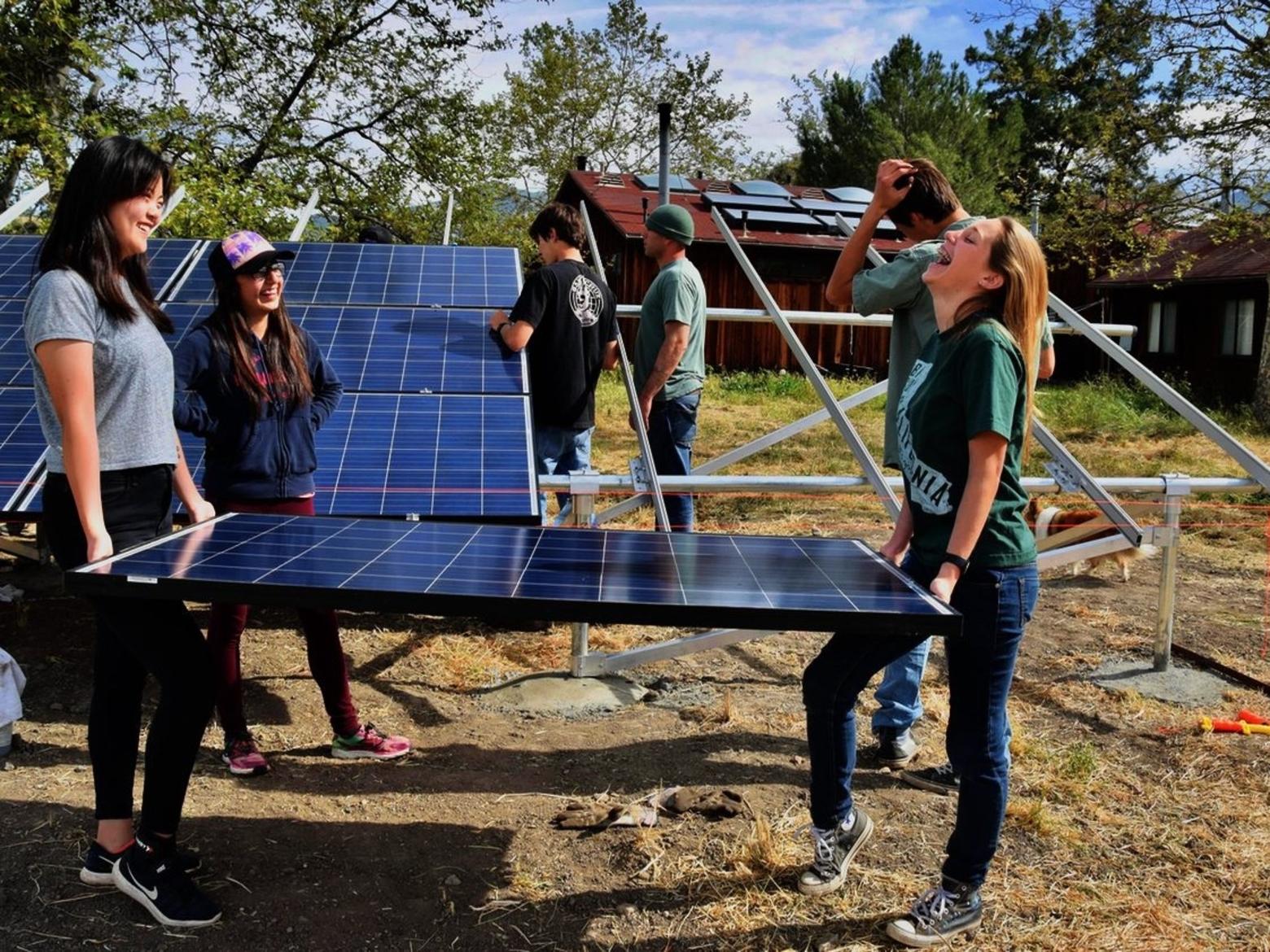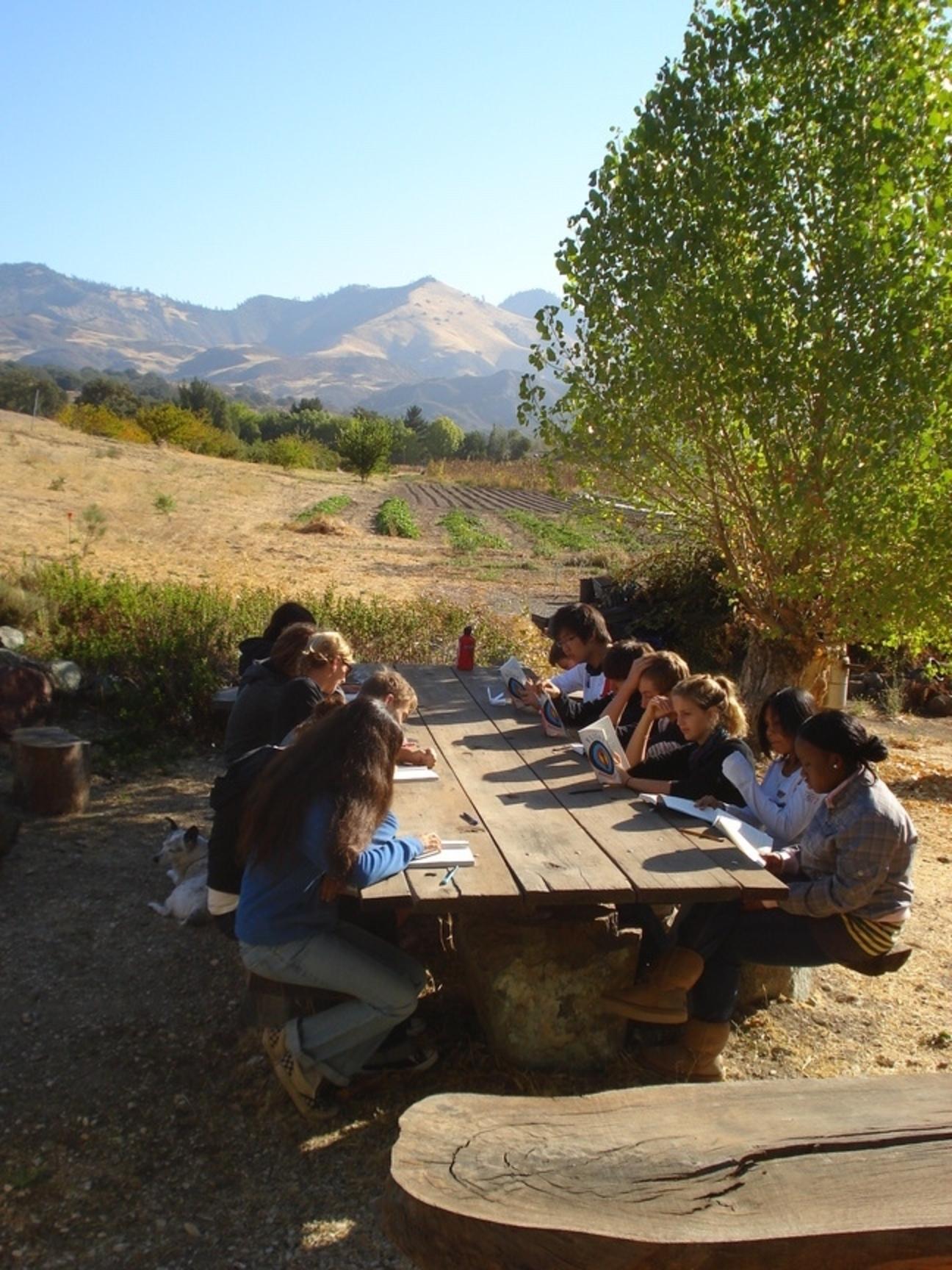Back to StoriesA Millennial Navigates The World Unplugged
July 23, 2018
A Millennial Navigates The World UnpluggedMoJo intern Sean Cummings went to a high school where digital trappings were forbidden, by design
In the first one, an extensive team of talented chefs in white outfits serve an endless assortment of delectable dishes: steamed broccoli and asparagus with lemon juice, basmati rice and spicy curry, artisan panini-style sandwiches. One table carries eight types of bread and six types of spread, another bears the weight of a dozen desserts. People flock to this hall, load their plates with food, and then…
...they find the most isolated seat they can, wolf the meal down alone, then pack up and head back to work. Most of them don’t know each other, and most never learn the names of the chefs who feed them.
In the second dining hall, people sit in groups of eight around square wooden tables, each bearing the same set of one main course, one salad, and one side. On a narrow wall counter, two types of bread and spread sit next to a 30-year-old conveyor-belt toaster. The food isn’t fancy, but it has the warmth and heart of a home-cooked meal, and the diners make eye contact and talk to each other. Each knows the others, and all of them know the chef personally.
Where would you rather eat?
I’ve experienced both. The first is Arrillaga Hall at Stanford University, where I attended before transferring to Whitman College. The second is Stillman Hall at Midland School in Los Olivos, California — my high school and home, as a child of faculty. I unequivocally prefer the latter.
Size accounts for much of the difference between the two — Arrillaga might serve three to four hundred people at a time, while Stillman holds little more than one hundred, making intimate conversation easier.
But there’s another factor at play here. In Arrillaga Hall, students dine with their eyes glued to their smartphones, while above them, enormous mounted television monitors display news channels or cooking shows.
In Stillman, at Midland, there are no television monitors. More impressively, not a single student has a phone.
In Arrillaga Hall, students dine with their eyes glued to their smartphones, while above them, enormous mounted television monitors display news channels or cooking shows. In Stillman, at Midland, there are no television monitors. More impressively, not a single student has a phone.
I trust most readers have heard of Stanford, but Midland, one of the last and best bastions against the overdependence of youth on technology, may require an introduction.
Founded by Harvard graduate Paul Squibb in 1932, Midland sought from the beginning to forego all nonessential elements of education, such as maintenance staff and, originally, electricity. By so doing, Squibb hoped to provide an affordable, high-quality college preparatory experience even in the midst of the Great Depression.
Of course, Midland has kept with the times to some degree — it now has electricity, almost 40 percent of which comes from solar panels installed by students. But the self-reliant, community-oriented philosophy remains. With no paid maintenance staff, students perform all chores on campus, from cleaning the bathrooms to washing the dishes to harvesting food from the garden. Those wanting a hot shower must gather and chop wood in order to build fires to heat the water. Think of it as a less intense, college-prep version of Deep Springs College.
But beyond the values of self-reliance and hard work, Midland students learn something just as important, if not more so: genuine, personal, non-digital connection with those around them.
Midland achieves this not only by asking students to sweep floors and scrub toilets together (each a surprisingly effective bonding experience in its own right), but also by removing unnecessary technological distractions. Midland students may not possess mobile phones, movies, televisions, or video games on campus. Internet may only be accessed in the library and classrooms, and most non-academic websites are blocked.
When they first arrive, many students don’t see the point. To them, banning internet and video games seems as outrageous as banning music or radio might have to their parents’ generation.
But losing the screens opens up time for other things. With no phones to turn to, students find new ways to pass the time. Some play music together; others initiate pickup soccer and basketball matches. Some of my favorite memories from my time there involve heated UNO games in a friend’s cabin with Tom Petty on the speakers.
In having these face-to-face interactions, students forge friendships faster and more strongly than if they were just texting each other. They also develop new interests they might never have discovered had the internet sucked up all their leisure time.
Students go outside. Set at the corner of almost 3,000 acres of chaparral and oak woodland adjacent to the Los Padres National Forest, Midland boasts an extensive network of trails for running, hiking, and camping. And the land around it is protected.
Better yet, Midlanders spend more time actually paying attention to the landscape around them rather than compulsively posting pictures of it to Instagram. They forget to construct superficial images of their lives on social media because they’re too busy actually living. They may not have photos to prove it, but the cuts and bruises they acquire on their hikes tell a richer story.
Above all, Midlanders know how to talk to each other. Instead of pulling out their phones at the dinner table, they look at each other, ask questions, laugh at the day’s antics. Five dinners a week at Midland are family-style, with each table headed by a senior or, more often, a faculty member, ensuring that students develop conversation skills with adults as well as peers.
In the evenings, rather than retreating to their respective devices, teens might converse over a cup of tea in the dining hall or lounge together on couches in the library — all without a single phone in sight.
Of course, many rebel, watching movies behind closed blinds at the risk of minor disciplinary action. But technological restrictions benefit even the rule-breakers. Forbidding electronic entertainment means students no longer take it for granted — when you have to do it in secret, watching movies becomes a luxury, not a god-given right.
It also challenges students’ creativity. In one case (the rumor goes), two students taught themselves how to set up a hidden private network for cross-cabin gaming, arguably a highly educational endeavor.
Some students even want to live without phones and choose Midland partly for this reason. For young people today, giving up technology in the name of real, personal connection may not always be an option — if the rest of your social circle depends on social media to communicate, you risk silencing yourself if you don’t use it also.
Midland fixes this by ensuring that nobody depends on social media. Once none of your friends have it, you’re free from the shackles as well.
Better yet, Midlanders spend more time actually paying attention to the landscape around them rather than compulsively posting pictures of it to Instagram. They forget to construct superficial images of their lives on social media because they’re too busy actually living.
Eventually, though, the shackles return. For some students, re-entering a high-tech environment upon graduating proves more difficult than leaving it was four years earlier. My transition to Stanford and the Silicon Valley proved extraordinarily challenging and sometimes, as in the case of Arrillaga Dining Hall, downright depressing. The proliferation of screens cast an air of distance and loneliness over the hall, making otherwise delicious food unpalatable. On many nights, I lost my appetite.
The move was made all the more difficult by the fact that, in addition to attending Midland for 9th through 12th grade, I grew up there as a faculty kid with a relatively low-tech childhood. I had no video games until 6th grade, and my screen time throughout elementary school maxed out at one movie per week (a rule implemented when, as a toddler, I threw a tantrum when my parents wouldn’t let me watch The Jungle Book for a fourth time in one sitting). Much of my childhood instead consisted of exploring Midland’s woodlands top to bottom.
This doesn’t mean technology was absent from my life. I used the internet occasionally and, at friends’ houses, played video games. Today, I do both as freely as I choose. Thanks to those childhood limitations, however, it’s just that: a choice, not an addiction. I never depended on a screen to entertain myself, and I know I never will.
Midland seeks to teach its students this same independence. At Midland, self-reliance doesn’t just apply to chopping your own wood — it also means relying on your own organic ingenuity to entertain yourself instead of just switching on a device.
This, to me, is part of what makes Midland so valuable. By all means, youth today need to keep up with the pace of technology, — if they don’t, they’ll be left in the dust and, honestly, they’ll miss out on some pretty damn cool stuff. Just as importantly, however, they need to be taught how to live independent from it. Social media claims to keep us connected, but those who depend on it will never truly connect with anyone or anything.
This holds true for people of all generations. The younger ones, however, stand at greater risk because we’re growing up in a time when technology dependence is the norm. Parents today give their toddlers toy smartphones and their ten-year-olds real ones, then sit them down in front of the television and stick iPads in their hands instead of books.
People have their own reasons for doing this, and I’m not here to pass judgement. I only wish to point out that this sets developing minds on a course that’s hard to break away from. When it’s all you’ve ever known, escape becomes difficult.
Those who learn not to depend on screens, however, will connect in ways that will serve them for the rest of their lives.
They will connect with the world around them. They will notice the feeling of sand between their toes and the sound of waves in their ears instead of wasting thirty minutes finding the right selfie angle only to drop their phone in the water. Instead of trying so hard to show everyone that they’re at the beach, they’ll focus on actually being at the beach.
They will connect with each other. When thrust into new and uncomfortable environments like Midland, they will reach out to others for new friendships, new conversations, new senses of belonging, rather than hiding behind their phones and texting only the friends they already have.
They will connect with themselves. Devices like smartphones often serve as a means of easy escape from difficult emotions we don’t feel like dealing with; they allow us to ignore our problems and let them fester. Removing the electronic distraction forces us to confront our demons, thereby improving our chances of ultimately conquering them. It also allows us to openly converse with loved ones who might wish to help us do so.
They will connect with information on a deeper level rather than a broader one. Technology brings us more information than ever before, but at the price of overwhelming our attention spans and increasing the shallowness of the information we consume. Those who learn not to click frantically at every next headline will develop the patience to read entire articles.
So, to those of you who read this far, good job. You might have done well at Midland.
Related Stories
August 14, 2018
Learning, To Care Deeply For Mother Nature
In Montana's Centennial Valley, the Taft-Nicholson Center opens minds for life by immersing students in the wild unknown






